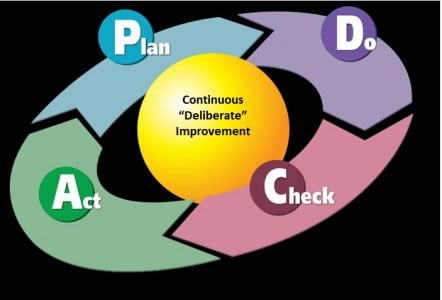Procurement’s Technological Insanity
“Insanity: doing the same thing over and over again and expecting different results.” –Albert Einstein.
Over on Sourcing Innovation, the Sourcing Doctor has an excellent series of posts on driving adoption of Procurement technology.
As someone who spent most of the last 15 years in the field of Procurement technology:
- in a Procurement organization, as a user first and, then, as a project manager driving implementation projects,
- working for a provider and helping customers in their projects,
The topic covered by the Sourcing Doctor is a topic that is close to my heart.
Also, I have been working, at the end of last year, on a white paper (still to be published) that focuses on change management and… adoption of Procurement technology. So, based on the research for the white paper, I had planned to post here, on Medium, a series on that topic.
The series of posts by the Sourcing Doctor and a recent post by Jon Hansen on Procurement Insight on a typical story of an adoption fail served as triggers to add my own thoughts and observations.
By doing so, I hope also to contribute to increasing awareness on the Procurement and the provider side because:
- I strongly believe in the beneficial impact of Procurement technology,
- There is a certain low maturity on the Procurement organization side (maybe because that they do not do such projects very often),
- There is also, sometimes, blissful ignorance on the buy-side regarding the effort such projects represent (esp. regarding change management and business transformation),
- Providers are also, at times, guilty of feeding that ignorance as they are under pressure of getting deals and, therefore, also minimize the budget needed for change and adoption.
And, whenever a project fails, the profession suffers (time, cost, credibility, …). So, it is in the interest of all involved to maximize the chance that implementation are successful and that those technological solutions are fully adopted.
An old story…
As the Sourcing Doctor states several times in his posts, Procurement technology is now quite “old.” Despite this, adoption is still relatively low. Projects after projects, the same issues.
Like in a time loop, the same story repeats itself.
John Kotter, in his bestseller from 1996, Leading Change reports that 70% of change initiatives in organizations and businesses fail. More recent sources reflect the same situation about failures or issues (over time, over budget…).
“The average large IT project runs 45% over budget, 7% over time, and delivers 56% less value than expected.” Source:Pulse of the Profession 2015, Project Management Institute, February 2015
And, year after year, the same findings:
Source: Pulse of the Profession 2016, Project Management institute, May 2016
The same applies to Procurement technology. Consider, as an illustration, the following quotes on the adoption of eSourcing from 2007 to 2016:
”Here are my Top Three Issues facing the [e-]sourcing world today — Adoption, Adoption, Adoption!” Source: Issues in eSourcing: adoption and penetration, eSourcing Forum, 2007
“Failure to fully leverage an eSourcing tool in 2014 is unacceptable” Source: CPO Rising, 2014
”If an eSourcing solution is not in place, change that. If one is in place, start driving and/or mandating its usage. They may be the single most effective value-driver for CPOs and procurement teams today.” Source: CPO Rising 2016: How the Best-in-Class Leverage eSourcing for Superior Performance
It is not just bloggers and writers who say that. Analysts and research firms, like the Aberdeen Group and the Hackett Group, come to the same conclusions. Here are statistics from some of their reports on the adoption of eSourcing by companies they define as “best-in-class”:
- 2015 ==> 68% (The best-in-class lead the way on eSourcing, Aberdeen, July 2015)
- 2014 ==> 70% (Why is eSourcing Adoption and Utilization Still So Low?, Spend Matters, Sept. 2014)
- …
- 2011 ==> 63% (The State of Strategic Sourcing 2011, Aberdeen Group, April 2011)
- 2010 ==> 57% (Strategic sourcing, the 2010 guide to driving savings and Procurement performance, Aberdeen Group, March 2010)
- …
- 2007 ==> 61% (The CPO’s Strategic Agenda 2007, Aberdeen Group, February 2007)
So, between 2007 and 2016 nothing much as changed. On one side, there is a widespread consensus on the value that organizations can get from using eSourcing:
”Best-in-Class sourcing and procurement teams also report average savings on their eSourcing projects that are 7% higher than the results of their competitors (9.8% average savings on eSourcing projects vs. 9.1%). They identified 14% greater savings than all other teams, and realized 10% greater savings than all other teams (7.7% vs. 6.9%)” Source: CPO Rising 2016: How the Best-in-Class Leverage eSourcing for Superior Performance
On the other side, usage stagnates and is far from being widespread.
So, as the example on eSourcing demonstrates it, the central question is: why people who would tremendously benefit from using “something” actually do not use that “something”?
To answer that question, one has to look at the psychology of change…
THE PSYCHOLOGY OF CHANGE… (PART 2/4)
“Insanity: doing the same thing over and over again and expecting different results.” –Albert Einstein
This is the second post in a series of four that focuses on the adoption of Procurement technologies. It will highlight some important aspects of the psychology of change because:
- they explain why so many projects fail,
- they must be taken into account to design a successful implementation.
The problem with changes…
“The only thing that is constant is change” — Heraclitus
What was true in Ancient Greece is even truer today. Especially when looking at changes induced by or linked to technology.
Despite the facts that:
- there is already an extensive literature on change management,
- some of the seminal works are now more than ten years old,
many organizations and change leaders fall into the same traps.
So, to develop the right approach and methodology, it is important to review what these pitfalls are.
The psychology of change management…
“Most change programs fail, but the odds of success can be greatly improved by taking into account […] counterintuitive insights about how employees interpret their environment and choose to act.” Source: The irrational side of change management, Mc Kinsey Quarterly, 2009
People are “Predictably Irrational” (to reuse the title of Dan Ariely’s bestseller). So, understanding how people make decisions is critical to take the right approach when presenting and selling a change.
Deciding (to change) is often not a logical or rational assessment of various options. Many factors come into play and influence us.
Also, organizations are living entities, and are also subject to forces that hinder change. These forces, too, must be acknowledged and counter-balanced with the right actions.
People are far from being rational…
At individual level change is difficult.
” Brain science has found that human beings are anything but reasonable. […] As managers, our misunderstanding about how the mind works causes most of what we do to not only be ineffective, but counterproductive. When it comes to motivation, our approach is based on the view of classical economic theory that people are rational beings trying to maximize their economic return. This leads us to use the promise of rewards to motivate the behavior we need. But in direct defiance of the theory, people don’t respond reasonably or objectively to the rewards.” Source: A Mind for Selling: Brain Science Is Turning Management On Its Head, Charles Jacobs, June 2009
Changing means moving from A to B. As illustrated by the quote above, the traditional way to build a change management program fails often. Various biases impact the perception that people have of A and B. Typically,
- A is overestimated,
- B is underestimated.
There is an imbalance that jeopardizes the success of a change initiative.
People are bad at being aware of what they currently do.
Part of the assessment to decide if a change is worth it or not requires the analysis of the current state (A). Also, Procurement technologies impact the way people work. So, the perception of how good people think that are at doing their job has an influence on their decision to change.
“The fact is that human beings consistently think they are better than they are — a phenomenon referred to in psychology as a self-serving bias” Source: The irrational side of change management, The McKinsey Quarterly, April 2009
It is, for example, why many people say “why would I need to change what I do when I am already achieving my targets.” They link their results solely to their actions, forget their own shortcomings, and elude how they got the results (be it with the help of a process, a tool, or other people).
People are bad at valuing a change.
Another important aspect of the decisions to change is about the value that people attribute to:
- what they currently have (A),
- what they could potentially get in the future (B).
There are two primary sources of influence at play that also hinder the rationality of that assessment:
- endowment effect: people attribute more value to something they own (A); just because they own it.
- risk aversion: people prefer not to take a risk when confronted with something new (B); they prefer complacency.
These two factors explain why just presenting a list of benefits to people who will have to change what they do is not enough to convince them and get them to embrace the change.
A typical mistake in Procurement is to think that the new technology is “so simple to use that people will adopt it immediately.” Many organizations do that mistake. It is true that easy-to-use technology is important as it will facilitate adoption:
But, using only that user-friendliness as sole motivator or sole justification for people to change will not work.
Time perception changes everything.
Another important aspect that explains in part the difficult to be rational and logical in valuing a change has to do with time. It is called time discountingand it represents “the relative valuation placed on a good at an earlier date compared with its valuation at a later date.”
It means, in short, that any benefit that people would get in x weeks or x months is undervalued vs. a similar reward that would come immediately or very soon.
Because
- project leaders “sell” benefits that people would only be able to see, measure, and enjoy once the project is completed,
- projects about the implementation of Procurement technology take time,
time discounting has a sizable effect.
The 9X effect…
All the biases above apply to the “target” side, the people who will go through the change. The thing is that the same exists on the other side.
People leading a change initiative are also biased.
It is because they are already convinced by it. They make the change and the future state (post-project) theirs. It means that the endowment effect is at play for them too. They overvalue the object of the change.
Therefore, we have a unique situation where:
- the people who will have to change:
- overestimate the benefits of what they have (endowment effect)
- underestimate the benefits of the change (risk aversion, time discounting)
- the people in charge of the change overestimate benefits.
The result is a mismatch in valuation by a factor of 9, the 9X effect.
Source: Eager Sellers and Stony Buyers: Understanding the Psychology of New-Product Adoption, John T. Gourville, Harvard Business Review, June 2006
Organizations are resilient to change…
At organization level, change is also difficult.
In the way they respond to change, organizations are like big jelly:
”The “theory” is that if you throw yourself and your team members, 100% mentally and physically, at the organization, in an attempt to change it, at best the organization will give a little shiver, momentarily, like a giant jelly, and then immediately return to its pre-existing shape and carry on, with business as usual, as though nothing has happened. Clearly this way is energy, effort and time consuming, with little or no discernible result.” Source: The Big Jelly Theory, Paul Finnerty, December 2013
Despite all efforts from change leaders, organizations are resilient to change, and the usual outcome is a return, after a while, to the previous state. A second image is valuable to understand why.
Organizations, especially large ones, can also be compared to oil tankers. Because of their large size and weight, oil tankers are extremely tough to pilot. A change of direction given by the captain on the wheel does not immediately alter the route of the ship. It takes a long time to see the ship turn.
The same is valid for organizations. Change, if it happens at all, takes a lot of time because of the inertia (size, culture of complacency…) of the organization. So, stirring an organization towards a new direction is like piloting a tanker: between the moment you impulse a change and the moment the organization actually changes, it lasts a long time.
Maybe because of all of the above, change leaders and organizations repeat, projects after projects, the same mistakes. The next post will review the most common ones.
REPEATING THE SAME MISTAKES OVER AND OVER… (PART 3/4)
“Insanity: doing the same thing over and over again and expecting different results.” –Albert Einstein
Here is the third post in a series of four that focuses on the adoption of Procurement technologies.
After looking at:
- statistics that demonstrate that, despite the relatively long existence of Procurement technology, low adoption is an old and recurrent story (part 1),
- some of the psychological reasons why change is difficult (part 2),
this post will cover some of the typical mistakes done in implementation projects and that can be easily prevented.
Some of the mistakes I will highlight find their origin in a fatal flaw: assumptions. Often, people leading a change assume without actually checking on the ground the validity of their opinions. From assuming that the change will be welcome to think that a limited change management will suffice, the curse of knowledge is at play.
Wrong approach and understanding of technology
In business, and especially in the community of domain experts, there is a tendency to look at technology as the solution to all problems and consider it as an end.
And, as Simona Pop says it:
“Technology is not the end goal. It was never the end goal and treating it as such will lead to failure. Technology is a tool to empower people. You cannot and should not forget it’s all about people and the effect you/what you do have on them.”
Also, another common misconception also hinders projects. Many organizations want to use a new technology by applying it to the current ways of doing things. Doing so, they miss the real value and transformative impact of technology.
“The usual methods for boosting performance — process rationalization and automation — haven’t yielded the dramatic improvements companies need. In particular, heavy investments in information technology have delivered disappointing results — largely because companies tend to use technology to mechanize old ways of doing business. They leave the existing processes intact and use computers simply to speed them up.” — Harvard Business Review, Reengineering Work: Don’t Automate, Obliterate.
Technology can automate an existing process, true. But, it also enables organizations to do things that were previously impossible.
What will new technology let us do that was previously impossible?
Technology lets us rethink the very structure of how we do things. Consider, for example, the way that Uber and Lyft have transformed urban transportation. There were connected taxicabs long before Uber — but all they did was to recreate the old process. What we got for our connectivity was a credit card reader in the back, and a small screen showing us ads. What Garrett Camp and Travis Kalanick realized was that humans were now augmented by location-aware smartphones, and so you could completely rethink the way you summoned a car. It would be utter magic to someone from the past — that you can click on your phone, and summon a car to where-ever you are, and to know just how long it will take for a car to pick you up.” — Tim O’Reilly, Don’t Replace People. Augment Them.
Absence of (or weak) meaning
Not having a real business case detailing why (a.k.a. goal, purpose, vision) the change is important is a surprising, but very frequent, mistake. Many organizations decide to implement Procurement solutions without a clear picture of what the benefits will be. They have a high-level idea; nothing more.
Because of the lack of purpose, it is then impossible to create the conditions for change, to motivate people and to drive adoption.
”If you don’t know where you are going, any road will get you there.” — Lewis Carroll
Not knowing where you are going negatively impacts an organization’s ability to define the project scope (which categories, which suppliers, which geographies, which processes…) and roll-out (what, where, when, how).
This can lead to:
- missing benefits as some areas will be left out of the project; areas that should have been included in the scope…
- implementing the solution on the wrong scope or on “everything” (the one-size-fits-all approach). This will be very damaging as it will give opponents of the change good arguments against the project.
Together with the impact on scope, not knowing “why” also hinders the ability to define what the deliverables of the project are. This leads to the next major cause of failures: poor requirement management.
Poor requirement management
The fact that there is often a misunderstanding of what technology can do, and, if you add on top of that, a weak business case, then it is no wonder that buying the right technology is often difficult for organizations. And buying the right tool starts with developing the right requirements.
“47% of unsuccessful projects fail to meet goals due to poor requirements management. ” Source: Requirements Management, a Core Competency for Project and Program Success, The Project Management Institue, August 2014
Also, not having a proper requirement management process negatively impacts a project’s budget, schedule or quality. It can even kill a project. Often, requirements are developed or refined along the way. This leads to:
- consuming time and energy that should be allocated to other activities,
- making change management for requirements/gap analysis impossible as a reference or baseline does not exist,
- making development, testing, and acceptance challenging and strenuous as there is no source of truth of what the deliverable(s) should be.
Focus on deployment, adoption is left for later
”We’ve spent an awful lot of money on technology, but I still see people working in the old way,” complained the CFO of a large hospitality company. The result is often widely deployed internal applications that no one actually uses effectively.” Source: Convincing Employees to Use New Technology, Didier Bonnet, September 2014
When an organization launches a project to deploy a new solution, there is an implicit understanding that it also means that the system will be used. But, here again, this is a typical mistake to assume that, because a system is in place, people will use it.
To make a parallel with savings, the difference between a deployed solution and an adopted solution is like the difference between negotiated savings and realized savings.
Too fast into action, not enough planning
”Organizations need to resist the temptation to succumb to pressure from business leaders to get started before the enterprise is really ready […]. Business leaders must understand what it will take to ensure success.” Source: Gartner Says Through 2018, 90 Percent of Organizations Will Lack a Postmodern Application Integration Strategy, Gartner, March 2016
This quote from Gartner, although in the context of ERP implementation, is also applicable to Procurement solution projects.
Individuals have a natural tendency to want to “produce.” They go too fast into action mode and skip some planning/thinking steps. Organizations, because of various sources of pressure, also have the same eagerness to see things happen fast. It adds even more pressure on project teams to deliver.
It happens very often that, even before the planning phase is over, project sponsors, as an example, ask the project manager: when are we live? When is the first workshop?
Being too fast into action and not allocating enough time to planning is a frequent mistake. It is interesting to note that Procurement practitioners know that 90% of the success of a negotiation is in the preparation, but forget that same principle when the topic is the implementation of a Procurement solution.
So, all these common mistakes can easily be avoided by being aware of them and by understanding what actually happens during the introduction of new technology. The fourth and last post in this series will detail that.
by Bertrand Maltaverne

Bertrand Maltaverne has extensive experience in the area of Procurement and, more precisely, in the impact of technology on procurement organizations. He currently works for a Procurement technology provider to help customers achieve success in the digital transformation of their procurement practice. Before that, he had various responsibilities in the procurement function of a Fortune 500 company. He is also active on various social media platforms, and he also blogs. Connect with him on LinkedIn.







